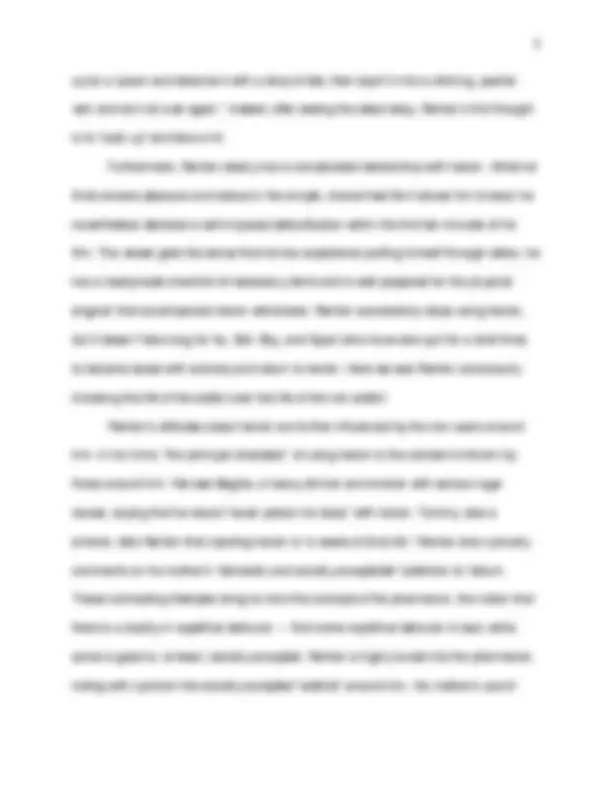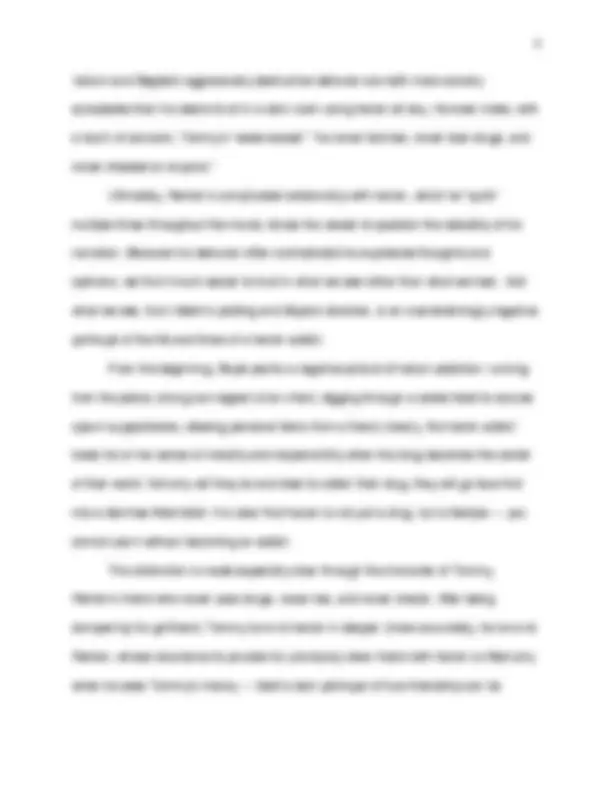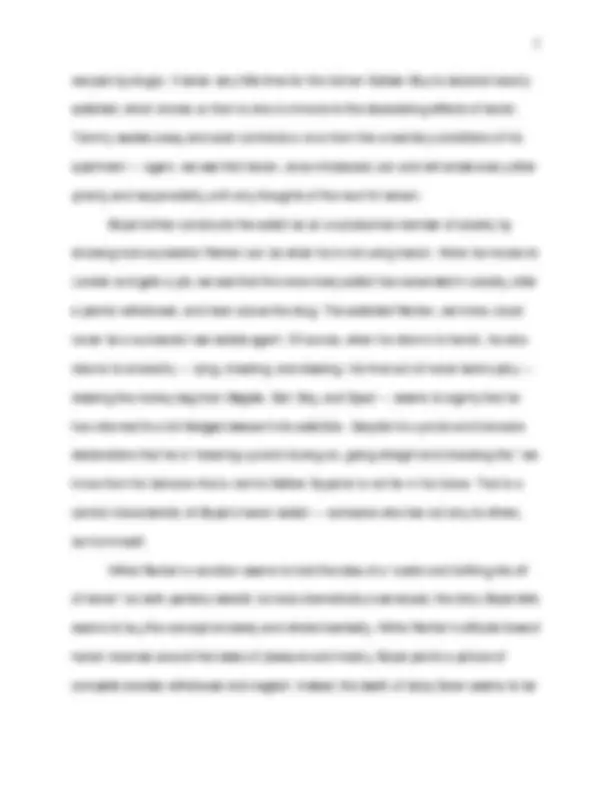





Study with the several resources on Docsity

Earn points by helping other students or get them with a premium plan


Prepare for your exams
Study with the several resources on Docsity

Earn points to download
Earn points by helping other students or get them with a premium plan
Community
Ask the community for help and clear up your study doubts
Discover the best universities in your country according to Docsity users
Free resources
Download our free guides on studying techniques, anxiety management strategies, and thesis advice from Docsity tutors
The intricate relationship between heroin addicts and pleasure as portrayed in Danny Boyle's film 'Trainspotting'. The text delves into the protagonist Mark Renton's conflicting attitudes towards heroin use and the societal perception of addicts as unproductive and morally bankrupt. The document also discusses the duality of pleasure and misery in heroin addiction and the impact of societal norms on drug users.
What you will learn
Typology: Study notes
1 / 6

This page cannot be seen from the preview
Don't miss anything!




Drug Use and the Addict in Trainspotting Danny Boyle’s Trainspotting , based on a novel of the same name by Irvin Welsh, follows a group of young heroin users during the late 1980s in Edinburgh, Scotland. We, the viewers, are given access to this group via the narration of protagonist Mark Renton, a self-proclaimed heroin addict, who introduces us to his friends and fellow addicts Sick Boy and Spud, along with his friends Begbie and Tommy who do not use heroin. Throughout the course of the film, Renton goes through several periods of being “on” and “off” of heroin, which correspond to various highs and lows in his story arc. Through these periods of heroin use and heroin withdrawal, we are shown an image of the heroin addict, while Renton’s narration gives us insight into the mentality and attitude of a heavy user. In many instances, Renton’s values and convictions surrounding life and heroin directly conflict with the overarching message of the film, which comes through in Welsh’s plot and Boyle’s imagery. The dual messages of Renton’s rocky relationship with heroin serve to challenge, and in some cases critique, some popular notions of heroin addiction. Ultimately, however, the film leaves its viewers with the common image of the heroin addict that perpetrates the mainstream — unproductive, morally bankrupt, and acutely self-centered. Mark Renton introduces himself as a man for whom heroin is the center of his life — a man who has made one choice in a society that asks us to make many. Rejecting these socially normative choices (“Choose life. Choose a job. Choose a career. Choose
a family. Choose a fucking big television, choose washing machines, cars, compact disc players and electrical tin openers,” etc.), Renton has made one choice — “I chose not to choose life. I chose something else.” — to use heroin. From the beginning, then, we are asked to juxtapose two distinct lives: that of the heroin-free, and that of the heroin user. These lives are, by nature, incompatible, as we will see through the polarity of Renton’s periods of drug use and withdrawal. Though Renton claims that he has no reason for doing heroin (“There are no reasons. Who needs reasons when you’ve got heroin?”), he soon reveals the often ignored or forgotten reason behind many heroin users’ habits: pleasure. The idea of pleasure is often entirely dismissed in the discussion of drugs, as society tends to see it as a luxury of the upper class, or something that must be earned. Drug users do not appear, by societal standards, to be living a pleasurable life. We see needle-marked arms and frail frames and think that the user must be suffering. In Renton’s words, “people think it's all about misery and desperation and death and all that shit … but what they forget is the pleasure of it.” And the pleasure, as he describes it, is immense: “Take the best orgasm you've ever had... multiply it by a thousand, and you're still nowhere near it.” For the heroin addict, there appears to be an interplay between pleasure and misery. Pleasure, of course, is what turned the non-user into the user — but the cycle of misery seems to play a bigger role in turning the user into the addict. After Renton and his friends, strung out on heroin, find Allison’s baby dead from neglect, their “only response was to keep on going and 'fuck everything' — pile misery upon misery, heap it
Valium and Begbie’s aggressively destructive behavior are both more socially acceptable than his desire to sit in a dark room using heroin all day. He even notes, with a touch of sarcasm, Tommy’s “weaknesses”: “he never told lies, never took drugs, and never cheated on anyone.” Ultimately, Renton’s complicated relationship with heroin, which he “quits” multiple times throughout the movie, forces the viewer to question the reliability of his narration. Because his behavior often contradicted his expressed thoughts and opinions, we find it much easier to trust in what we see rather than what we hear. And what we see, from Welsh’s plotting and Boyle’s direction, is an overwhelmingly negative portrayal of the life and times of a heroin addict. From the beginning, Boyle paints a negative picture of heroin addiction: running from the police; strung out neglect of an infant; digging through a soiled toilet to recover opium suppositories; stealing personal items from a friend; clearly, the heroin addict loses his or her sense of morality and responsibility when the drug becomes the center of their world. Not only will they lie and steal to obtain their drug, they will go face first into a diarrhea-filled toilet. It is clear that heroin is not just a drug, but a lifestyle — you cannot use it without becoming an addict. This distinction is made especially clear through the character of Tommy, Renton’s friend who never uses drugs, never lies, and never cheats. After being dumped by his girlfriend, Tommy turns to heroin in despair (more accurately, he turns to Renton, whose reluctance to provide his previously clean friend with heroin is lifted only when he sees Tommy’s money — itself a dark portrayal of how friendship can be
warped by drugs). It takes very little time for this former Golden Boy to become heavily addicted, which shows us that no one is immune to the devastating effects of heroin. Tommy wastes away and soon contracts a virus from the unsanitary conditions of his apartment — again, we see that heroin, once introduced, can and will erode every other priority and responsibility until only thoughts of the next hit remain. Boyle further constructs the addict as an unproductive member of society by showing how successful Renton can be when he is not using heroin. When he moves to London and gets a job, we see that this once lowly addict has ascended in society, after a painful withdrawal, and risen above the drug. The addicted Renton, we know, could never be a successful real estate agent. Of course, when he returns to heroin, he also returns to amorality — lying, cheating, and stealing. His final act of moral bankruptcy — stealing the money bag from Begbie, Sick Boy, and Spud — seems to signify that he has returned to a full-fledged descent into addiction. Despite his cynical and insincere declarations that he is “cleaning up and moving on, going straight and choosing life,” we know from his behavior that a visit to Mother Superior is not far in his future. That is a central characteristic of Boyle’s heroin addict — someone who lies not only to others, but to himself. While Renton’s narration seems to hold the idea of a “useful and fulfilling life off of heroin” as both partially realistic but also dramatically overvalued, the story Boyle tells seems to buy the concept sincerely and whole-heartedly. While Renton’s attitude toward heroin revolves around the ideas of pleasure and misery, Boyle paints a picture of complete societal withdrawal and neglect. Indeed, the death of baby Dawn seems to be